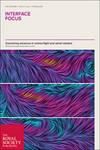The biomechanics of splitting hairs
IF 3.6
3区 生物学
Q1 BIOLOGY
引用次数: 1
Abstract
Splitting of hair, creating ‘split ends’, is a very common problem which has been extensively documented. However, the mechanics underlying the splitting phenomenon are poorly understood. This is partly owing to the lack of a test in which splitting can be generated and quantified under laboratory conditions. We developed three new tests, known as ‘loop tensile’, ‘moving loop’ and ‘moving loop fatigue’, aiming to simulate the mechanical environment of tangles of hair strands during combing. We tested straight strands of human hair, comparing low-quality hair (from a subject who experienced split ends) with hair from a control (non-splitting) subject. Significant differences were found, especially in the moving loop fatigue test where the low-quality hair failed in fewer cycles. Splitting occurred in both types of hair, but with the crucial difference that in the low-quality hair, splits originated inside the hair strand and propagated longitudinally over considerable distances, while in the control hair, splits originated at the strand surface and remained short. Bleaching of the control hair changed its behaviour, making it similar to that of the low-quality hair. Some simple calculations emphasized the role of longitudinal shear stress and shear stress intensity in generating microcracks which could then propagate within the moving loop, paving the way for a future theoretical model of the splitting mechanism.分毫不差的生物力学
头发开叉造成 "发尾分叉",是一个非常常见的问题,已有大量文献记载。然而,人们对头发开叉现象背后的机理却知之甚少。这部分是由于缺乏可在实验室条件下产生分叉并进行量化的测试。我们开发了三种新测试,分别称为 "发圈拉伸"、"移动发圈 "和 "移动发圈疲劳",旨在模拟梳理过程中发丝打结的机械环境。我们对人类的直发进行了测试,并将低质量头发(来自有发梢分叉现象的受试者)与对照组(无分叉)受试者的头发进行了比较。结果发现两者之间存在显著差异,尤其是在移动循环疲劳测试中,劣质头发在较少的循环周期内就会出现故障。两种类型的头发都发生了分叉,但重要的区别在于,劣质头发的分叉源于发丝内部,并纵向扩展了相当长的距离,而对照组头发的分叉源于发丝表面,并保持较短的长度。对照组头发的漂白改变了其行为,使其与劣质头发相似。一些简单的计算强调了纵向剪切应力和剪切应力强度在产生微裂缝中的作用,这些微裂缝随后会在移动环路中传播,这为未来建立劈裂机制的理论模型铺平了道路。
本文章由计算机程序翻译,如有差异,请以英文原文为准。
求助全文
约1分钟内获得全文
求助全文
来源期刊

Interface Focus
BIOLOGY-
CiteScore
9.20
自引率
0.00%
发文量
44
审稿时长
6-12 weeks
期刊介绍:
Each Interface Focus themed issue is devoted to a particular subject at the interface of the physical and life sciences. Formed of high-quality articles, they aim to facilitate cross-disciplinary research across this traditional divide by acting as a forum accessible to all. Topics may be newly emerging areas of research or dynamic aspects of more established fields. Organisers of each Interface Focus are strongly encouraged to contextualise the journal within their chosen subject.
文献相关原料
| 公司名称 | 产品信息 | 采购帮参考价格 |
|---|
 求助内容:
求助内容: 应助结果提醒方式:
应助结果提醒方式:


